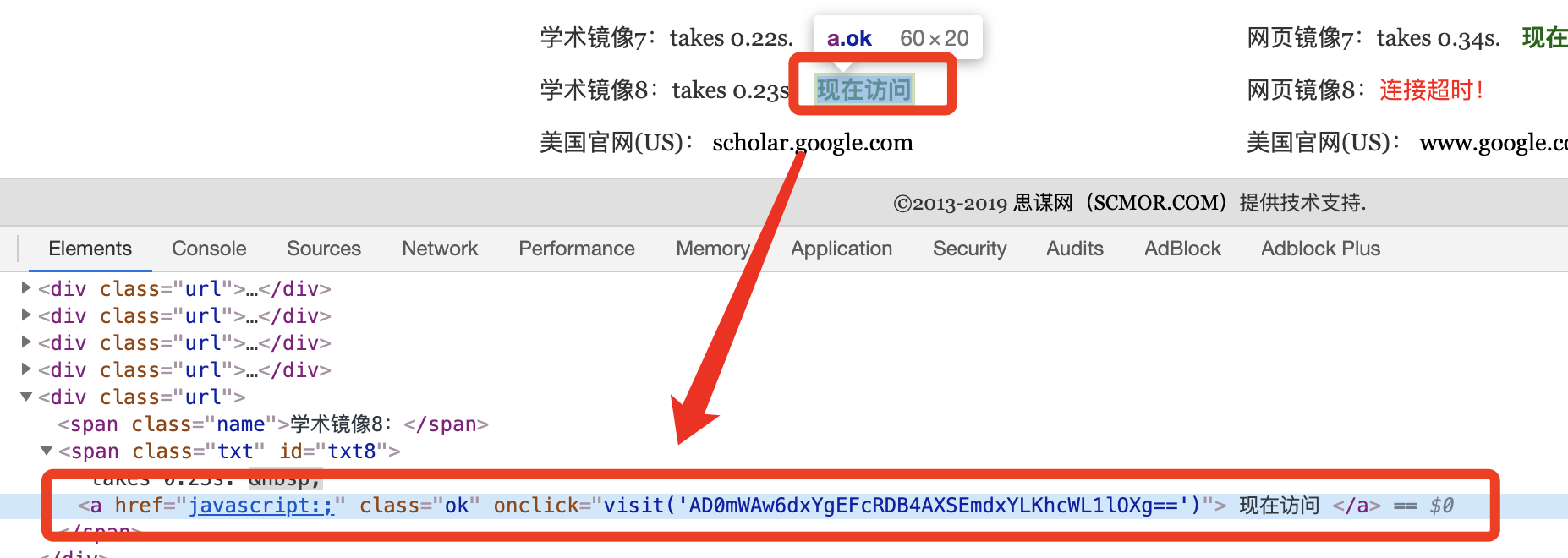爬虫笔记之Google镜像导航链接JS加密破解(http://ac.scmor.com/)
这是个非常非常简单的js加密链接。
这是一个导航网站,实际链接到的网站的url被加密了,并没有直接显示在页面上,首先开发者模式选中链接元素:

发现这个链接有一个onclick事件,是调用了visit方法传入了一个很长的看上去像是base64的字符串,猜测实际的url应该就是根据这个字符串生成的,但是怎么跟进去visit方法呢,这个方法能够在html中直接访问到,说明其作用域是全局的,那么切换到console面板,输入刚才那个函数的名称visit回车将其打印:

单击输出,跳转到函数所在的代码:

可以看到这部分关键的代码在strdecode函数中,如法炮制,跳转到strdecode所在的代码:

单击跳转:

这部分用到了两个全局变量,Gword和hn,通过搜索请求找到这两个变量都在页面doc里声明的:

hn就是域名的主机名部分转为小写,即“ac.scmor.com”,然后就是Gword貌似是作者的邮箱,这样写在页面代码中还不得被各种爬虫发的小广告给烦死啊。。。

搞清楚了这两个变量,再回到之前的js:

默认情况下每个链接都会有一串看上去像是base64的字符串,这里strdecode传入的参数就是那个字符串,传进来的字符串首先进行base64解码,然后基于Gword和hn转换为一个新的base64编码的字符串,然后继续对其base64解码,就得到了最终的url。
根据上面的逻辑编写出代码:
1 2 3 4 5 6 7 8 9 10 11 12 13 14 15 16 17 18 19 20 21 22 23 24 25 26 27 28 29 30 31 32 33 34 35 36 37 38 39 40 41 42 43 44 45 46 47 48 49 50 51 52 53 54 55 56 57 58 59 60 61 62 63 64 65 66 67 68 69 70 71 72 73 74 75 76 77 78 79 80 81 82 83 84 85 86 87 88 89 90 91 92 93 94 95 96 97 98 99 | package cc11001100.misc.crawler.js.acscmorcom;import cc11001100.misc.crawler.utils.HttpUtil;import lombok.extern.slf4j.Slf4j;import org.apache.commons.lang3.StringUtils;import org.jsoup.Connection;import java.util.ArrayList;import java.util.Base64;import java.util.Collections;import java.util.List;import java.util.regex.Matcher;import java.util.regex.Pattern;/** * http://ac.scmor.com/ * * @author CC11001100 */@Slf4jpublic class AcscmorcomCrawler { public static List<String> getMirrorSiteLink() { String responseBody = HttpUtil.request("http://ac.scmor.com/", null, Connection.Response::body); if (StringUtils.isBlank(responseBody)) { log.error("response empty"); return Collections.emptyList(); } Matcher matcher = Pattern.compile("autourl\\[\\d+] = \"(.+?)\"").matcher(responseBody); List<String> result = new ArrayList<>(); while (matcher.find()) { result.add(decodeToLink(matcher.group(1))); } return result; } /** * <pre> * function strdecode(string) { * string = base64decode(string); * key = Gword + hn; * len = key.length; * code = ''; * for (i = 0; i < string.length; i++) { * var k = i % len; * code += String.fromCharCode(string.charCodeAt(i) ^ key.charCodeAt(k)); * } * return base64decode(code); * } * </pre> * * @param likeBase64 * @return */ private static String decodeToLink(String likeBase64) { String hn = "ac.scmor.com"; String gword = "author: link@scmor.com."; String s1 = base64DecodeToString(likeBase64); String key = gword + hn; StringBuilder result = new StringBuilder(); for (int i = 0; i < s1.length(); i++) { char c = (char) (s1.charAt(i) ^ key.charAt(i % key.length())); result.append(c); } return base64DecodeToString(result.toString()); } private static String base64DecodeToString(String raw) { return new String(Base64.getDecoder().decode(raw)); } public static void main(String[] args) {// System.out.println(decodeToLink("AD0mWAw2VVYgWiAdDB4LHQwqaxY2XxcVL0M9FiEYTxM=")); List<String> list = getMirrorSiteLink(); System.out.println("count: " + list.size()); list.forEach(System.out::println);// count: 16// http://so.hiqq.com.cn/// https://sci-hub.org.cn/// https://xueshu.soogle.top// http://www.ndtsg.com/// https://www.80xueshu.com/// https://xs.glgoo.top/scholar// https://scholar.123admin.com/// https://g3.luciaz.me/scholar// http://nav.hiqq.com.cn/twy/// https://a.g456.top// https://g.sudo.gq/// https://q.g456.top// https://ice.g456.top// http://206.189.135.241/// https://www.kuaimen.bid/// https://gg.chn.moe/ }} |
输出:

.
分类:
爬虫相关




【推荐】国内首个AI IDE,深度理解中文开发场景,立即下载体验Trae
【推荐】编程新体验,更懂你的AI,立即体验豆包MarsCode编程助手
【推荐】抖音旗下AI助手豆包,你的智能百科全书,全免费不限次数
【推荐】轻量又高性能的 SSH 工具 IShell:AI 加持,快人一步
· 10年+ .NET Coder 心语,封装的思维:从隐藏、稳定开始理解其本质意义
· .NET Core 中如何实现缓存的预热?
· 从 HTTP 原因短语缺失研究 HTTP/2 和 HTTP/3 的设计差异
· AI与.NET技术实操系列:向量存储与相似性搜索在 .NET 中的实现
· 基于Microsoft.Extensions.AI核心库实现RAG应用
· 10年+ .NET Coder 心语 ── 封装的思维:从隐藏、稳定开始理解其本质意义
· 地球OL攻略 —— 某应届生求职总结
· 提示词工程——AI应用必不可少的技术
· Open-Sora 2.0 重磅开源!
· 周边上新:园子的第一款马克杯温暖上架